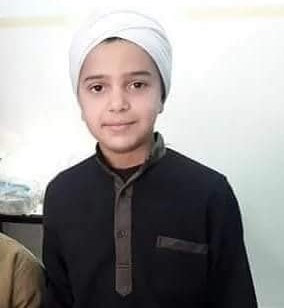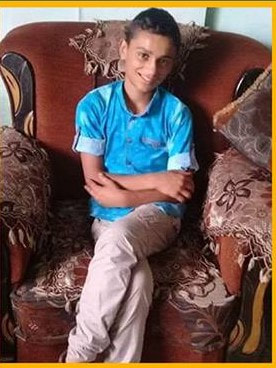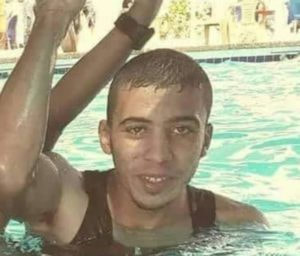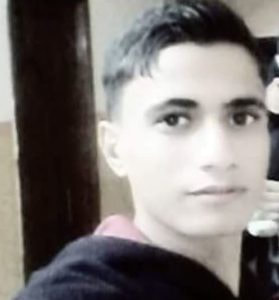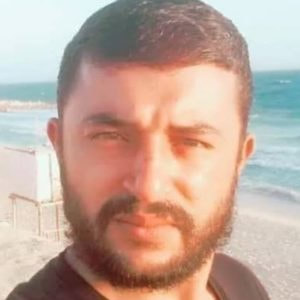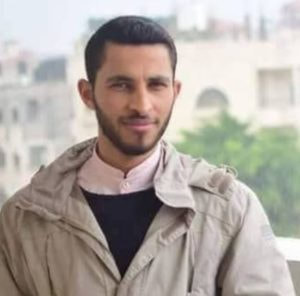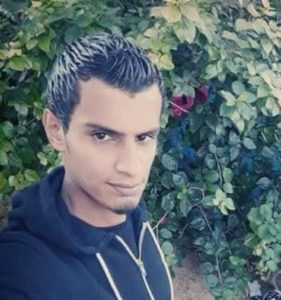2 oct 2018
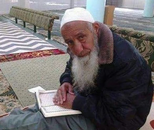
Ibrahim al-Arrouqi, 78
An elderly Palestinian man was killed on Tuesday evening by Israeli tank fire east of al-Maghazi refugee camp in the middle area of the Gaza Strip.
The PIC reporter said that Ibrahim al-Arrouqi, 78, was hit with a 250-mm bullet fired by an Israeli tank stationed on the Israeli side of the border fence east of Gaza.
He added that al-Arrouqi was shot while sitting in front of his house which is relatively far from the border fence.
An elderly Palestinian man was killed on Tuesday evening by Israeli tank fire east of al-Maghazi refugee camp in the middle area of the Gaza Strip.
The PIC reporter said that Ibrahim al-Arrouqi, 78, was hit with a 250-mm bullet fired by an Israeli tank stationed on the Israeli side of the border fence east of Gaza.
He added that al-Arrouqi was shot while sitting in front of his house which is relatively far from the border fence.
28 sept 2018
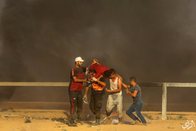
by Nabil Salem
The government in Israel presents us with more proof, every day, that it represents and adopts an aggressive approach that is not interested in peace, or even willing to respect international laws and conventions. It also gives us evidence that it wages wars for the sake of it and in order to satisfy its rampant desire for aggression and expansion, serving its criminal objectives against the Arabs in general, and the Palestinian people in particular.
Although Israel’s leaders have typically hidden the objectives of their violent wars under various pretexts, such as preventative or pre-emptive action and other justifications that they try to promote to the world, it is noteworthy that, despite their various operational names, these wars are not all that Israel is doing or thinking about. There are wars for other reasons that demonstrate the moral decline of Israel’s ruling establishment and the level of criminality and brutality it has reached.
In a report by Israeli writer Rogel Alpher, in Haaretz, he explains why Israel might launch another war against the people of Gaza.
While the occupying state always tries to justify its aggression as “self-defence”, Alpher reveals that a new war is needed so that the Israeli arms industry and Defence Forces can field test new weapons and ammunition against live targets. This is sickening.
Although he also mentioned that, among the reasons which may lead Israel to war are internal disputes and the upcoming elections, the fact that it can even be talked about testing new weaponry, in this way, is itself criminal and potentially a flagrant violation of all morality and international laws and conventions. It also reaffirms what was revealed by Israeli film-maker Yotam Feldman in his 2013 film, The Lab. So, this is nothing really new.
If we take into account the unjust siege imposed by the Israeli occupation on more than two million Palestinians in the Gaza Strip, turning the enclave into the largest prison in the world, the testing of Israeli weapons in the territory adds a new and shameful dimension to the ongoing Israeli crimes against the Palestinian people. We can also throw in Israel’s use of internationally banned weapons over a number of years.
We would need a lot of time and effort to record all Israeli crimes committed against the Palestinians, from pre-1948 to today. The state of Israel itself was founded on massacres of Palestinian civilians by Zionist terrorist gangs. Since then, there have been countless crimes committed, including unlawful killings, forced displacement, arbitrary detention, the siege and other unjustifiable restrictions on movement, illegal settlements and discriminatory policies and practices, including openly racist laws.
It goes without saying that Israel would not have been able to commit all of these crimes without the unlimited and unquestioned support of many colonial powers, particularly the US, and the willful disdain for international public opinion and international law. Unfortunately, it seems that such legal restraints are only to be used when it suits the victors of World War Two and the other nuclear powers. They do not intend to restore the rights of oppressed peoples, but to justify persecution or injustice under false slogans and pretexts.
As such, it is logical to say that Israel will not stop committing its crimes, but will intensify them, as long as there is no Arab power ready to stop it or a serious will to contain and limit its criminal role in our region. The colonial state not only threatens peace and security in the Middle East, but also around the whole world. Its weapons testing, on live targets in the besieged Gaza Strip, is a clear demonstration of the fact that Israel will stop at nothing to achieve its aims and objectives.
~ Middle East Monitor/Days of Palestine
Opinion/Analysis 09/25/18 World Bank: Gaza’s Economy Now In ‘Free Fall’
The government in Israel presents us with more proof, every day, that it represents and adopts an aggressive approach that is not interested in peace, or even willing to respect international laws and conventions. It also gives us evidence that it wages wars for the sake of it and in order to satisfy its rampant desire for aggression and expansion, serving its criminal objectives against the Arabs in general, and the Palestinian people in particular.
Although Israel’s leaders have typically hidden the objectives of their violent wars under various pretexts, such as preventative or pre-emptive action and other justifications that they try to promote to the world, it is noteworthy that, despite their various operational names, these wars are not all that Israel is doing or thinking about. There are wars for other reasons that demonstrate the moral decline of Israel’s ruling establishment and the level of criminality and brutality it has reached.
In a report by Israeli writer Rogel Alpher, in Haaretz, he explains why Israel might launch another war against the people of Gaza.
While the occupying state always tries to justify its aggression as “self-defence”, Alpher reveals that a new war is needed so that the Israeli arms industry and Defence Forces can field test new weapons and ammunition against live targets. This is sickening.
Although he also mentioned that, among the reasons which may lead Israel to war are internal disputes and the upcoming elections, the fact that it can even be talked about testing new weaponry, in this way, is itself criminal and potentially a flagrant violation of all morality and international laws and conventions. It also reaffirms what was revealed by Israeli film-maker Yotam Feldman in his 2013 film, The Lab. So, this is nothing really new.
If we take into account the unjust siege imposed by the Israeli occupation on more than two million Palestinians in the Gaza Strip, turning the enclave into the largest prison in the world, the testing of Israeli weapons in the territory adds a new and shameful dimension to the ongoing Israeli crimes against the Palestinian people. We can also throw in Israel’s use of internationally banned weapons over a number of years.
We would need a lot of time and effort to record all Israeli crimes committed against the Palestinians, from pre-1948 to today. The state of Israel itself was founded on massacres of Palestinian civilians by Zionist terrorist gangs. Since then, there have been countless crimes committed, including unlawful killings, forced displacement, arbitrary detention, the siege and other unjustifiable restrictions on movement, illegal settlements and discriminatory policies and practices, including openly racist laws.
It goes without saying that Israel would not have been able to commit all of these crimes without the unlimited and unquestioned support of many colonial powers, particularly the US, and the willful disdain for international public opinion and international law. Unfortunately, it seems that such legal restraints are only to be used when it suits the victors of World War Two and the other nuclear powers. They do not intend to restore the rights of oppressed peoples, but to justify persecution or injustice under false slogans and pretexts.
As such, it is logical to say that Israel will not stop committing its crimes, but will intensify them, as long as there is no Arab power ready to stop it or a serious will to contain and limit its criminal role in our region. The colonial state not only threatens peace and security in the Middle East, but also around the whole world. Its weapons testing, on live targets in the besieged Gaza Strip, is a clear demonstration of the fact that Israel will stop at nothing to achieve its aims and objectives.
~ Middle East Monitor/Days of Palestine
Opinion/Analysis 09/25/18 World Bank: Gaza’s Economy Now In ‘Free Fall’

Nasser Musabeh 12 video video video
Mohammed al-Houm, 14 video
Iyad al-Shaer, 18 video
Mohammed Inshasi, 18 video
Mohammed Haniyeh 24
Mohammed Shakhsa, 24
Mohammed al-Awawda, 26
At least seven Palestinian civilians were killed and dozens injured on Friday when the Israeli occupation army opened fire at the Palestinians protesting along Gaza border with the 1948 occupied Palestinian territories.
Thousands of Palestinians took part in the protests of the 27th Friday of the Great March of Return which was named "Friday of al-Aqsa Intifada".
According to Gaza's Health Ministry, the martyrs were identified as Mohammed al-Houm, 14, Iyad al-Shaer, 18, Mohammed Shakhsa, 24, Mohammed Inshasi, 18, and Mohammed al-Awawda, 26. The identity of two other martyrs is still unknown.
Spokesman for the ministry Ashraf al-Qedra said that 506 Palestinians were injured, 90 of whom by live ammunition, and three of whom are in critical condition.
Among the injured are 35 children, four women, four paramedics, and two journalists. video
The Higher National Committee for the Great March of Return earlier this week called for the largest participation in the activities of the 27th Friday of the Great March of Return which would be organized particularly to mark the anniversary of al-Aqsa Intifada.
The committee in a statement affirmed that Gaza border protests will continue until the siege is lifted and refugees are allowed to return to their homes from which they were expelled in 1948.
Mohammed al-Houm, 14 video
Iyad al-Shaer, 18 video
Mohammed Inshasi, 18 video
Mohammed Haniyeh 24
Mohammed Shakhsa, 24
Mohammed al-Awawda, 26
At least seven Palestinian civilians were killed and dozens injured on Friday when the Israeli occupation army opened fire at the Palestinians protesting along Gaza border with the 1948 occupied Palestinian territories.
Thousands of Palestinians took part in the protests of the 27th Friday of the Great March of Return which was named "Friday of al-Aqsa Intifada".
According to Gaza's Health Ministry, the martyrs were identified as Mohammed al-Houm, 14, Iyad al-Shaer, 18, Mohammed Shakhsa, 24, Mohammed Inshasi, 18, and Mohammed al-Awawda, 26. The identity of two other martyrs is still unknown.
Spokesman for the ministry Ashraf al-Qedra said that 506 Palestinians were injured, 90 of whom by live ammunition, and three of whom are in critical condition.
Among the injured are 35 children, four women, four paramedics, and two journalists. video
The Higher National Committee for the Great March of Return earlier this week called for the largest participation in the activities of the 27th Friday of the Great March of Return which would be organized particularly to mark the anniversary of al-Aqsa Intifada.
The committee in a statement affirmed that Gaza border protests will continue until the siege is lifted and refugees are allowed to return to their homes from which they were expelled in 1948.
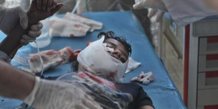
The latest figures provided by the Ministry of Health (MoH) indicate that, during the demonstrations between the 10th and 22nd of September, ten Palestinians, including four children, were killed and 1,193 were injured by Israeli forces.
Out of the total 1,193 injured, 690 patients required transfer to the MoH hospitals or NGO clinics, including 127 children and 37 females. Of the hospitalized injured, 19 cases were critically life threatening, 275 moderate, 386 mild, and the remaining 10 were unspecified cases (see also figures 1 and 2 on the following page).
The MoH and the Palestinian Red Crescent Society (PRCS) set up a total of ten Trauma Stabilization Points (TSPs), with the tenth one established at the beach north of Gaza. At least 503 injured patients were managed at the TSPs and discharged at the TSPs. The World Health Organization (WHO) continues to strengthen the capacity of the TSPs, across Gaza, to provide life-saving interventions.
According to the PNN, Gaza’s 14 public hospitals rely on donated fuel to run generators during the electricity black-outs, which continue to last up to 18-20 hours per day. The last batch of UN donated fuel has been distributed during August of 2018. Local authorities have since procured 120,000 litres, and a charity organization (Human Appeal International) has provided 10,500 litres, to sustain services at public hospitals throughout the month of September.
Nevertheless, hospitals are rationalizing the use of the remaining fuel reserves by suspending sterilization, laundry, cleaning, catering and selected diagnostic services during electricity cuts.
On 17 September the Humanitarian Coordinator (HC), announced the release of US$1.0 million from the humanitarian fund for fuel procurement. This support will ensure uninterrupted electricity supply for up to 250 critical health and water and sanitation facilities for a period of up to 6-7 weeks.
In August of 2018, the Central Drug Store of the MoH in Gaza reported 47% of essential drugs, at less than one month’s supply, and 40% completely depleted. 30% of essential disposables were at less than one month’s supply.
Click here for WHO Situation Report
Out of the total 1,193 injured, 690 patients required transfer to the MoH hospitals or NGO clinics, including 127 children and 37 females. Of the hospitalized injured, 19 cases were critically life threatening, 275 moderate, 386 mild, and the remaining 10 were unspecified cases (see also figures 1 and 2 on the following page).
The MoH and the Palestinian Red Crescent Society (PRCS) set up a total of ten Trauma Stabilization Points (TSPs), with the tenth one established at the beach north of Gaza. At least 503 injured patients were managed at the TSPs and discharged at the TSPs. The World Health Organization (WHO) continues to strengthen the capacity of the TSPs, across Gaza, to provide life-saving interventions.
According to the PNN, Gaza’s 14 public hospitals rely on donated fuel to run generators during the electricity black-outs, which continue to last up to 18-20 hours per day. The last batch of UN donated fuel has been distributed during August of 2018. Local authorities have since procured 120,000 litres, and a charity organization (Human Appeal International) has provided 10,500 litres, to sustain services at public hospitals throughout the month of September.
Nevertheless, hospitals are rationalizing the use of the remaining fuel reserves by suspending sterilization, laundry, cleaning, catering and selected diagnostic services during electricity cuts.
On 17 September the Humanitarian Coordinator (HC), announced the release of US$1.0 million from the humanitarian fund for fuel procurement. This support will ensure uninterrupted electricity supply for up to 250 critical health and water and sanitation facilities for a period of up to 6-7 weeks.
In August of 2018, the Central Drug Store of the MoH in Gaza reported 47% of essential drugs, at less than one month’s supply, and 40% completely depleted. 30% of essential disposables were at less than one month’s supply.
Click here for WHO Situation Report
24 sept 2018
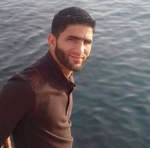
Mohammad Fayez Salim Abu Sadeq, 21
Israeli soldiers killed, Monday, one Palestinian and injured 90 others, during a protest in northern Gaza, especially at the shore where many boats attempted to sail and challenge the ongoing Israeli siege on the coastal region.
Media sources in Gaza said the soldiers fired a barrage of live fire, in addition to high-velocity gas bombs and rubber-coated steel bullets.
The Health Ministry in Gaza has confirmed that the soldiers killed Mohammad Fayez Salim Abu Sadeq, 21, and injured ninety other Palestinians, including ten who were shot with live fire.
It added that the soldiers also fired a gas bomb directly at a Palestinian Red Crescent ambulance, while trying to reach some of the wounded protesters.
Furthermore, the soldiers shot Monser Sawwaf, a cameraman working of the Anadolu Turkish News Agency, with a gas bomb in his leg, while live rounds also struck his camera and equipment.
It is worth mentioning that, using slingshots, Palestinian protesters managed to down an Israeli drone while firing gas bombs at them.
The soldiers also fired many gas bombs and live rounds at the boats, trying to break the illegal siege on Gaza.
Israeli soldiers killed, Monday, one Palestinian and injured 90 others, during a protest in northern Gaza, especially at the shore where many boats attempted to sail and challenge the ongoing Israeli siege on the coastal region.
Media sources in Gaza said the soldiers fired a barrage of live fire, in addition to high-velocity gas bombs and rubber-coated steel bullets.
The Health Ministry in Gaza has confirmed that the soldiers killed Mohammad Fayez Salim Abu Sadeq, 21, and injured ninety other Palestinians, including ten who were shot with live fire.
It added that the soldiers also fired a gas bomb directly at a Palestinian Red Crescent ambulance, while trying to reach some of the wounded protesters.
Furthermore, the soldiers shot Monser Sawwaf, a cameraman working of the Anadolu Turkish News Agency, with a gas bomb in his leg, while live rounds also struck his camera and equipment.
It is worth mentioning that, using slingshots, Palestinian protesters managed to down an Israeli drone while firing gas bombs at them.
The soldiers also fired many gas bombs and live rounds at the boats, trying to break the illegal siege on Gaza.
23 sept 2018
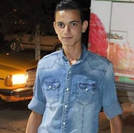
Emad Daoud Eshteiwi, 21
The Palestinian Health Ministry has reported that Israeli soldiers killed, on Sunday evening, a young Palestinian man, and injured at least 20 others, including one medic, along the eastern part of the besieged Gaza Strip.
Dr. Ashraf al-Qedra, the spokesperson of the Health Ministry in Gaza, said the soldiers shot Emad Daoud Eshteiwi, 21, with a live round in the head, east of Gaza city, and moderately injured a medic in the leg.
He added that the soldiers also shot twenty Palestinians with live rounds, along the perimeter fence, in the eastern parts of the coastal region, especially east of the al-Boreij refugee camp, in central Gaza, as the army shot at least 14 Palestinians.
The Palestinians were shot during the ongoing Great Return March processions in the besieged Gaza Strip, while many burnt tires in an attempt to block the sniper vision of the Israeli soldiers, stationed hundreds of meters away, across the perimeter fence.
In addition, Israeli drones fired missiles at protesters near the fence, east of Gaza city, causing several injuries.
The Palestinian Health Ministry has reported that Israeli soldiers killed, on Sunday evening, a young Palestinian man, and injured at least 20 others, including one medic, along the eastern part of the besieged Gaza Strip.
Dr. Ashraf al-Qedra, the spokesperson of the Health Ministry in Gaza, said the soldiers shot Emad Daoud Eshteiwi, 21, with a live round in the head, east of Gaza city, and moderately injured a medic in the leg.
He added that the soldiers also shot twenty Palestinians with live rounds, along the perimeter fence, in the eastern parts of the coastal region, especially east of the al-Boreij refugee camp, in central Gaza, as the army shot at least 14 Palestinians.
The Palestinians were shot during the ongoing Great Return March processions in the besieged Gaza Strip, while many burnt tires in an attempt to block the sniper vision of the Israeli soldiers, stationed hundreds of meters away, across the perimeter fence.
In addition, Israeli drones fired missiles at protesters near the fence, east of Gaza city, causing several injuries.
21 sept 2018
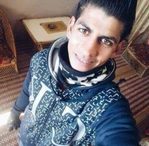
Karim Mohammad Kollab, 25
A Palestinian citizen was killed and dozens others injured on Friday when the Israeli occupation forces (IOF) heavily opened fire at peaceful protesters taking part in the Great March of Return along the border fence east of Gaza.
Gaza Ministry of Health said that Karim Kullab, 25, died after being shot east of Gaza city, while about 312 protesters suffered teargas inhalation and live ammunition wounds.
Thousands of Palestinians marched on 26th Friday of the Great March of Return along the border between the Gaza Strip and the 1948 occupied Palestinian territories.
The PIC reporter said that Palestinian youths launched fire balloons and kites over the border fence and set dozens of car tires on fire to block the view of IOF snipers who were shooting at the protesters.
Over the past week, the IOF has killed 10 Palestinians and injured hundreds others during the daily protests of the Great March of Return.
Since the start of the Great March of Return in Gaza, 193 Palestinian civilians have been killed, including 32 children, and over 20,000 injured by Israeli gunfire and airstrikes.
The Great March of Return mainly calls for lifting Gaza blockade and for allowing Palestinian refugees to return to their lands from which they were expelled in 1948 as stipulated by UN resolutions, especially Resolution 194 which provides for return or compensation.
Updated: “Israeli Army Kills One Palestinian, Injures 312, In Gaza”
Israeli soldiers killed, Friday, a young man, and injured 312 other Palestinians, including 54 with live fire, after the army attacked the Great Return March processions, in several parts of the Gaza Strip.
The Palestinian Health Ministry in Gaza has confirmed that the soldiers killed Karim Mohammad Kollab, 25, after shooting him with live fire, east of Gaza city.
It added that the soldiers also injured 312 Palestinians, including 100 with live fire.
100 of the wounded Palestinians were rushed to hospitals in the Gaza Strip, while five of the injured residents suffered life-threatening wounds.
The Health Ministry also said that among the wounded are twenty children and two women.
In related news, an Israeli tank fired a shell at Palestinian protesters near the perimeter fence, east of Gaza city, while an Israeli drone fired two missiles at a site, east of Gaza.
According to online Israeli daily Haaretz, the army carried out several air strikes in northern Gaza, and quoted the military alleging that a number of protesters “hurled explosives and grenades,” in addition to burning tires.
It added that one soldier was mildly injured by shrapnel, while firefighters extinguished six blazes caused by flaming balloons and kites, near the border area.
On Wednesday, September 19, 2018, the soldiers killed a Palestinian child, identified as Mo’men Ibrahim Abu Eyada, 15, after shooting him in the head while he was participating in a non-violent protest east of Rafah, in the southern part of the Gaza Strip.
On Tuesday, September 18, 2018, the soldiers killed four Palestinians, at dawn and during evening hours, east of Khan Younis, and near Beit Hanoun (Erez) Terminal in northern Gaza, and injured dozens of residents with live fire, in addition firing many gas bombs and concussion grenades causing many to suffer the effects of teargas inhalation.
The slain Palestinians have been identified as Ahmad Mohammad Mohsin Omar, 20, from the al-Shati’ refugee camp, Mohammad Ahmad Abu Naji, 34, from Jabalia, in addition to Naji Jamil Abu ‘Aassi, 18, and Ala’ Ziad Abu ‘Aassi, 21, from Khan Younis.
On the same day, the soldiers killed Mohammad Yousef Sha’ban Oleyyan, 26, in occupied East Jerusalem, in addition to Mohammad Zaghloul al-Khatib, 24, after assaulting him in his home in Beit Rima town, northwest of Ramallah, in central West Bank.
Updated From:
One Palestinian Killed, Dozens More Injured in Gaza
Published on: Sep 21, 2018 @ 20:45
One Palestinian was killed and 41 were wounded by live Israeli fire, during protests at the Gaza border, on Friday, the Gaza Health Ministry said.
Dr. Ashraf Al-Qadra, the spokesman for the Ministry of Health, reported that 41 different cases, including 30 injuries, were transferred to the hospital. Among the injuries were 21 live bullets, of which 3 were serious.
Al- Qadra said that Kareem Mohammed Kallob, 25, was shot by Israeli snipers while participating in the Great Return March, near the border fence, east of Gaza City.
Four of the wounded were said to be in serious condition. The Health Ministry said that 159 people were wounded altogether, of whom 55 required hospitalization.
Local sources said that Israeli tanks fired an artillery shell near a crowd of citizens, close to the border fence, east of Gaza City, while an Israeli drone fired two missiles at a site east of the city and its entire passage.
Over 180 Palestinians have been killed and thousands others injured since the outbreak of the Gaza border protests, on March 30. The protests call for ending the 12-year-long Israeli blockade of Gaza and for the right of return of the refugees.
A Palestinian citizen was killed and dozens others injured on Friday when the Israeli occupation forces (IOF) heavily opened fire at peaceful protesters taking part in the Great March of Return along the border fence east of Gaza.
Gaza Ministry of Health said that Karim Kullab, 25, died after being shot east of Gaza city, while about 312 protesters suffered teargas inhalation and live ammunition wounds.
Thousands of Palestinians marched on 26th Friday of the Great March of Return along the border between the Gaza Strip and the 1948 occupied Palestinian territories.
The PIC reporter said that Palestinian youths launched fire balloons and kites over the border fence and set dozens of car tires on fire to block the view of IOF snipers who were shooting at the protesters.
Over the past week, the IOF has killed 10 Palestinians and injured hundreds others during the daily protests of the Great March of Return.
Since the start of the Great March of Return in Gaza, 193 Palestinian civilians have been killed, including 32 children, and over 20,000 injured by Israeli gunfire and airstrikes.
The Great March of Return mainly calls for lifting Gaza blockade and for allowing Palestinian refugees to return to their lands from which they were expelled in 1948 as stipulated by UN resolutions, especially Resolution 194 which provides for return or compensation.
Updated: “Israeli Army Kills One Palestinian, Injures 312, In Gaza”
Israeli soldiers killed, Friday, a young man, and injured 312 other Palestinians, including 54 with live fire, after the army attacked the Great Return March processions, in several parts of the Gaza Strip.
The Palestinian Health Ministry in Gaza has confirmed that the soldiers killed Karim Mohammad Kollab, 25, after shooting him with live fire, east of Gaza city.
It added that the soldiers also injured 312 Palestinians, including 100 with live fire.
100 of the wounded Palestinians were rushed to hospitals in the Gaza Strip, while five of the injured residents suffered life-threatening wounds.
The Health Ministry also said that among the wounded are twenty children and two women.
In related news, an Israeli tank fired a shell at Palestinian protesters near the perimeter fence, east of Gaza city, while an Israeli drone fired two missiles at a site, east of Gaza.
According to online Israeli daily Haaretz, the army carried out several air strikes in northern Gaza, and quoted the military alleging that a number of protesters “hurled explosives and grenades,” in addition to burning tires.
It added that one soldier was mildly injured by shrapnel, while firefighters extinguished six blazes caused by flaming balloons and kites, near the border area.
On Wednesday, September 19, 2018, the soldiers killed a Palestinian child, identified as Mo’men Ibrahim Abu Eyada, 15, after shooting him in the head while he was participating in a non-violent protest east of Rafah, in the southern part of the Gaza Strip.
On Tuesday, September 18, 2018, the soldiers killed four Palestinians, at dawn and during evening hours, east of Khan Younis, and near Beit Hanoun (Erez) Terminal in northern Gaza, and injured dozens of residents with live fire, in addition firing many gas bombs and concussion grenades causing many to suffer the effects of teargas inhalation.
The slain Palestinians have been identified as Ahmad Mohammad Mohsin Omar, 20, from the al-Shati’ refugee camp, Mohammad Ahmad Abu Naji, 34, from Jabalia, in addition to Naji Jamil Abu ‘Aassi, 18, and Ala’ Ziad Abu ‘Aassi, 21, from Khan Younis.
On the same day, the soldiers killed Mohammad Yousef Sha’ban Oleyyan, 26, in occupied East Jerusalem, in addition to Mohammad Zaghloul al-Khatib, 24, after assaulting him in his home in Beit Rima town, northwest of Ramallah, in central West Bank.
Updated From:
One Palestinian Killed, Dozens More Injured in Gaza
Published on: Sep 21, 2018 @ 20:45
One Palestinian was killed and 41 were wounded by live Israeli fire, during protests at the Gaza border, on Friday, the Gaza Health Ministry said.
Dr. Ashraf Al-Qadra, the spokesman for the Ministry of Health, reported that 41 different cases, including 30 injuries, were transferred to the hospital. Among the injuries were 21 live bullets, of which 3 were serious.
Al- Qadra said that Kareem Mohammed Kallob, 25, was shot by Israeli snipers while participating in the Great Return March, near the border fence, east of Gaza City.
Four of the wounded were said to be in serious condition. The Health Ministry said that 159 people were wounded altogether, of whom 55 required hospitalization.
Local sources said that Israeli tanks fired an artillery shell near a crowd of citizens, close to the border fence, east of Gaza City, while an Israeli drone fired two missiles at a site east of the city and its entire passage.
Over 180 Palestinians have been killed and thousands others injured since the outbreak of the Gaza border protests, on March 30. The protests call for ending the 12-year-long Israeli blockade of Gaza and for the right of return of the refugees.
